MR Interviews Vintage Iron's Rick Doughty
by Michael McCook #41
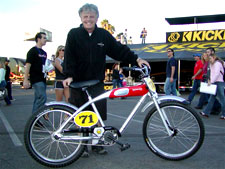 No doubt, here comes the most widely read and revealing Interview in the history of MR! Are you ready VMX’rs? Love him or hate him, here’s the inside scoop on rabid VMX Guru Rick Doughty! No doubt, here comes the most widely read and revealing Interview in the history of MR! Are you ready VMX’rs? Love him or hate him, here’s the inside scoop on rabid VMX Guru Rick Doughty!
MR: I have to say up front Rick that this is the most challenging interview I’ve done. As a matter of course, the readers will want to know your history. Tell us how you were first introduced to two-wheels and about those who were influential to you in those early days.
RD: I think it all started when I was about 8 months old. I used to stand at the back of my stroller and wheelie down the long hills in San Francisco where I was born. OK, that is not completely true. I was born on an Air Force base in Florida and my first two-wheeler was a tricycle that my neighbors had thrown away because one of the wheels had broken off. Interestingly enough it was also my first restoration. A can of purple Krylon and some handlebar tassels and I was stylin’. I couldn’t find a left rear wheel because back in those days there was no VINTAGE IRON for vintage tricycles, so I just learned to ride it by leaning to the right, which is also how I became the youngest member of the Republican Party at age 3.
From there I was hooked on anything with two wheels. After about 10 years of purple-framed Sting Ray bicycles, we got a Taco 22 mini bike, primarily because it was the only one that came stock with a purple frame. The only downside was I had to share it with my brother and he did not always think I was living up to the 50/50 deal. Being the big brother I felt obligated to explain the ways of the world to him. My explanations usually caused bruising on various parts of his body that eventually (you guessed it) turned purple.
Our family had moved to the Mojave Desert, where the Air Force tests all its latest and greatest technology, which didn’t mean diddlysquat to me. What I lived for was wide open riding area and 365 days of riding weather! At 12 years 115 degrees is still acceptable riding weather.
The Taco was not an only child for long. Soon we had a small collection of bikes; comprised of stuff no one else wanted or could justify repairing. A Honda S65, a BSA C15 (POS) and brand new, gay as hell step through 90. Not exactly a stable of dreams.
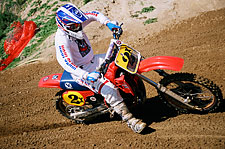 It wasn’t until my Dad was out of town, that I got my first two-stroke. I sold the BSA to someone with a lower I.Q. than dirt and bought a used ’69 Yamaha AT-1 Enduro. I probably owned it about seven minutes before I stripped all the lights and crap off it. Oh yeah, I pulled the silencer core out so it made close to the right noise too. Of course I couldn’t ride it for two weeks after being put on restriction for selling the BSA without permission but hey, looking at the AT-1 in the garage was way better than riding that British bucket of Whitworth bolts. It wasn’t until my Dad was out of town, that I got my first two-stroke. I sold the BSA to someone with a lower I.Q. than dirt and bought a used ’69 Yamaha AT-1 Enduro. I probably owned it about seven minutes before I stripped all the lights and crap off it. Oh yeah, I pulled the silencer core out so it made close to the right noise too. Of course I couldn’t ride it for two weeks after being put on restriction for selling the BSA without permission but hey, looking at the AT-1 in the garage was way better than riding that British bucket of Whitworth bolts.
MR: So now you’re in your Teens. At what point did competitive motorcycling come into your life and who were your influences?
RD: Living in the Mojave desert, my first motorcycle heroes we desert racers like J.N. Roberts and Whitey Martino. I also thought the dirt track guys were cool like Dave Aldana and Gene Romero. I had never seen a dirt track race but it was covered heavily in Cycle World magazine, which was the only motorcycle magazine I could get in ’68.
I remember there was a section in the back that was dedicated to the racing scene in Europe and occasionally they would have something about motocross. I would read it over and over trying to learn the names of all the top guys and grand prix tracks. The whole idea of riding a dirt bike over rough ground in front of thousands of people seemed about as tough as it could get and I liked tough.
They say that you always remember your first time and when it comes to someone that has raced for as long as I have, that applies to racing too. It is funny how insignificant things become important over time and the slightest encouragement can send a kid off in a direction that changes their life. Such was the case with my first race.
My first competitive event wasn’t so much a race as it was a field meet. Field meets were popular events with clubs where they would have everything from a slow race to trying to bite a hot dog on a string. The Desert Wheels motorcycle club on Edwards Air Force Base was no exception.
In the morning briefing I was clearly instructed by my Dad, the Colonel, not to participate. I was authorized to be a spectator only. “Yes sir, Dad sir” was the answer he was looking for and damn sure the one I gave him. The whole idea of competing in front of the adults and fast guys in the base club was pretty intimidating. I was glad to be part of the scene and did my best Marlon Brando impression as I sat on my Honda S65 and watched the first couple of events unfold. I don’t really recall what they were but as I watched I saw people having fun that were actually not very good riders at all. I thought some day I’ll be showing off my bikes skills and I will really be part of the “in-crowd.”
One of the head club members came over to the group of us kids and asked if we wanted to participate in the barrel race, which consisted of racing the clock while weaving in and out of six 55 gallon drums and then spinning around and blasting back through them to the finish line. Sounded simple enough so I raised my hand, knowing full well all my buddies would follow my lead and jump in too. Of course they didn’t and I was the lone juvenile in the event.
 I think the sound of snickering from the spectators, most of which were my friends, was louder than the straight pipe I had adapted to the S65. I think the sound of snickering from the spectators, most of which were my friends, was louder than the straight pipe I had adapted to the S65.
As the green flag waved and I dropped the clutch, my Dad’s strict orders evaporated from my brain. I did my best to power slide the 8 hp Honda in and out of the barrels without crashing like a rodeo clown and even though it seemed it took forever the whole experience was over in a flash (a lot like another first time story). Seemingly unimpressed the official jotted down my time on a clipboard and called the next guy to the line. I was too embarrassed to ask how my time was so I retired back to spectator status.
The next event up was an observed trails where you had to ride around some sage brush, through some rocks and then make your way over a fallen Joshua tree two-feet in diameter. The club officer told me to jump in again and I wasn’t about to disrespect an elder. I made it 90% through the section without a single dab, much to the amazement of my friends. That was until I got to the two-foot round tree. I yanked on the bars and goosed the S65 for all she was worth hoping to loft the front wheel high enough to clear the log and to my
surprise I was successful in clearing the front wheel but horizontal Honda motor was another matter altogether. It impaled itself into the soft log and promptly ejected me over the bars in a most entertaining manner, at least to my friends and the assorted on lookers. That is when I learned the true and humiliating meaning of “observed” trials.
I picked myself up and swatted off the dust, extracted the still teetering and still running Honda. The rest of the day was more of the same. I would get some stuff right and some stuff horribly wrong. By the end of the day, I figured I had made a complete ass out of myself and buddies would never let me live it down.
With the events over the club guys did what club guys do. They commenced to drinking beer, telling lies and handing out trophies. Somewhere in the process one of my pals said they heard them call my name but I wasn’t about to walk up there just to find out they were playing a practical joke on me. So I just sat there on my bike and waited for them to continue with the awards ceremony but they didn’t. Soon I realized that everyone was looking at me and I had less than a clue of to what to do. Luckily the club officer walked over and handed me a small trophy. I told him that I wasn’t even entered and I didn’t do any good, so there must be a mistake. He looked at his clipboard and informed me that I beat all the adults in the barrel race and the other club members liked how I wouldn’t quit even if I crashed, so the trophy was mine. To a 12-year-old kid it was like getting an Oscar at the Academy Awards.
The elation lasted about as long as it took my younger brother to remind me that my Dad was going to blow a head gasket when he found out that I disobeyed a direct order about non-participation.
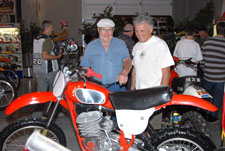 I decided that honesty was the best policy and as long as the Colonel didn’t see the trophy, I could be honest. I gave it to one of my peanut gallery friends to keep at his house and for the next two weeks that is where it resided. I would go by and visit it on my way home from school until I just couldn’t take it anymore. So one day I just brought it home and sat it in the middle of the kitchen counter. I was praying for a good old catholic miracle wherein my Dad, the Colonel would be so overcome with pride he would forget about my breach of authority. I must have been a couple of Hail Mary’s short because when he walked in from work and saw the trophy sitting there in all its glory he asked where it came from. I told him I had won it two weeks earlier. “Didn’t I tell not to race?”, he said in his I out rank you tone. I decided that honesty was the best policy and as long as the Colonel didn’t see the trophy, I could be honest. I gave it to one of my peanut gallery friends to keep at his house and for the next two weeks that is where it resided. I would go by and visit it on my way home from school until I just couldn’t take it anymore. So one day I just brought it home and sat it in the middle of the kitchen counter. I was praying for a good old catholic miracle wherein my Dad, the Colonel would be so overcome with pride he would forget about my breach of authority. I must have been a couple of Hail Mary’s short because when he walked in from work and saw the trophy sitting there in all its glory he asked where it came from. I told him I had won it two weeks earlier. “Didn’t I tell not to race?”, he said in his I out rank you tone.
“Yes sir”, I replied in my wavering non-commissioned kid voice.
“Restriction. Two weeks. No motorcycle.” Succinct and to the point, it’s the military way.
Where was St. Pete when I need him? Maybe God can hear you when you swear…
It took about three or four days before he started to ask me questions about the event like how many people participated and how I did against the adults. I told him in full detail with maximum enthusiasm but he remained stoic and unimpressed. According to my mom, he was bragging it up at the officers club the following Friday night but none of that got me any time off my sentence. Two weeks felt like two years but when it was finally over and I went back out to the desert, I was no longer just a rider, I was a racer and had a trophy to prove it.
Of course my first motocross race would draw that assumption into question in a big way but that is another story.
MR: It’s interesting how our parents used our passion to discipline us at times…great story. Take us right into your first Motocross race, how that turned out and tell us about your racing career.
RD: As I mentioned, while my dad, The Colonel was out of town I had sold off my BSA C15. I had and used the money to parlay it into the purchase of a year old Yamaha AT-1 Enduro. At the time it was only a year old and light years better than the archaic BSA. Mind you, it still had lights, trials tires and an electric starter so we aren’t talking a full-fledged motocross bike.
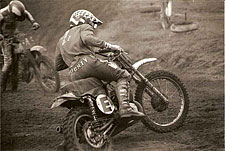 I stripped it down (a term for removing everything but the essentials) within 15 minutes of getting it home. I got a “hand me down” expansion chamber that made more noise than power and a set of number plates made out of a street sign. I was set to take on the world. I stripped it down (a term for removing everything but the essentials) within 15 minutes of getting it home. I got a “hand me down” expansion chamber that made more noise than power and a set of number plates made out of a street sign. I was set to take on the world.
Desert races were everywhere, every weekend in 1969 but motocross races were a bit more infrequent out in the high desert, so when one was held, everybody showed up.
My first outing was to a place called “Dead Man’s Point”. Sounded like something right out of a cowboy movie but looked more like the pig farm it formerly was. It was completely flat ground with the only interesting features being a section that went between some huge boulders and two large water holes. I am not sure how water holes became synonymous with motocross but they were mandatory in southern California during the late sixties and at Dead Man’s they subscribed to “the bigger the better” approach to waterholes. The took a bulldozer and dug out two forty yard sections four feet deep and filled them with three feet worth of water. They made sure to refill them repeatedly throughout the day so as not to disappoint the spectators.
Needless to say, riding in the desert every day did little to prepare me for this form of motocross. I had no earthly idea of what to do when I rounded the corner that lead into the first waterhole, so I employed the “when in doubt, gas it” advice that had been handed down to me from one of my knucklehead friends. Gas it I did and pull on the bars as hard as I could. I then executed the text book “flying W” and went head first over the bars and into the waterhole which had now become a mud hole. Undaunted, I scrambled back to my bike and hit the starter button, dog paddling my way out of the swamp. Back on solid ground I tried my best to shake it off and concentrate on the track that was until I came upon mud hole number two. I decided to learn from my earlier mistakes and try a different approach. This time I dropped the front end into the quagmire first. The outcome was quite predictable. The front wheel stuck in the mud and bike spit me off like Brahma bull would a three year old. As I laid there in there in the muck, I began to think that desert racing might have been a wiser choice. Hell, staying home and cleaning my room might have been preferable.
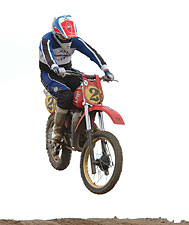 I picked up the now unrecognizable Yamaha and slung my leg over the seat. I pushed the electric start button and nothing. The kick-starter wouldn’t even bring the AT-1 back to life, so my first experience in the world of motocross was reduced to a half a lap and long push back to the pits, where the guys I came with quickly pointed out that my air cleaner had sucked muddy water into the motor. I couldn’t believe that an air cleaner named “green weenie” had failed me so miserably. That would never happened in desert I thought. After cleaning all the goo out of the carb, the cylinder and the ignition we threw in a new spark plug and lucky me she fired right up. I picked up the now unrecognizable Yamaha and slung my leg over the seat. I pushed the electric start button and nothing. The kick-starter wouldn’t even bring the AT-1 back to life, so my first experience in the world of motocross was reduced to a half a lap and long push back to the pits, where the guys I came with quickly pointed out that my air cleaner had sucked muddy water into the motor. I couldn’t believe that an air cleaner named “green weenie” had failed me so miserably. That would never happened in desert I thought. After cleaning all the goo out of the carb, the cylinder and the ignition we threw in a new spark plug and lucky me she fired right up.
I was about to race my first motocross and I had not made a full lap of practice. My buddies convinced that it would be just like riding in the desert over ground I hadn’t seen and I was pretty good at that. In retrospect, they were probably baiting me into riding over my head but I didn’t know any better.
The hand on helmet start was another thing I had never done nor practiced, so I was far from the front of the pack but I wasn’t last, at least not yet. I was doing pretty well on the first section of the course that I had done in practice and I was actually passing guys. That was until we got to the mud hole. I was all pumped up on testosterone and stupidity so I held the throttle wide-open going into the drop off and to my surprise I cleared the mud hole. The problem my bike did not. It had managed to catapult me on to solid ground when it became entrenched in the now case deep mud. I jumped up and slogged my way back to the bike and restarted it. With a great deal of throttle and slipping clutch I managed to extract it and get under way. That was until (you guessed it) the next mud hole.
Back in those days, we rode three motos and for the duration of those three motos, I learned precious little about racing motocross. I did however learn more ways to involuntarily dismount into the mud than I thought possible because I crashed at least twice a lap, every lap.
I had serious, serious misgivings about this sport called motocross and doubted that I would ever put myself through so much humiliation again. There was nothing fun about it and after all, that was what it was supposed to be. What a let down, what a disappointment.
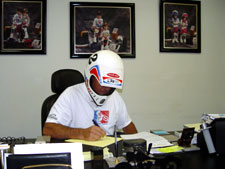 I went back to the base and desert riding and honestly thought it would never ride another motocross race. I went back to the base and desert riding and honestly thought it would never ride another motocross race.
Then I had the opportunity to tag along to a motocross school put on by Husqvarna. The instructors were Gunnar Lindstrom and Mark Blackwell (the first 500cc National champ). The things I learned that day would have taken me years to figure out in the desert and it rekindled my interest in motocross. Hell, now I was a student of the sport I figured and armed with all this knowledge imparted to me by the Moto Gods, I should be able to go out there and kick some serious ass. Funny how the teenage mind works…
The problem boiled down to the fact that I was still riding an enduro bike with trails tires and as hard as I would try the only ass kicking I was handing out was to myself. I didn’t have a clue about tires, suspension, engine tuning or real physical training and it showed. I worked my way up to being a middle of the pack 125 Novice and that was about as good as it got.
Until one day the local club announced that they were going hold the first ever motocross race on the base. I was really excited. Not only could I ride my bike to the race but I knew how to ride in the desert and this motocross track was going to be laid out in the desert.
For a change, things went to plan and I was leading my first motocross race and running away with it like I had always seen it in my head. The dream however would have to wait as my Yamaha ignition decided it needed a nap. I changed plugs; I kicked and kicked and kicked that thing until I was flat exhausted and nothing. It was a long walk back to the pits, let me tell you. The upside was I proved to myself I was competitive, more competitive than my bike.
The next race they had on the base was the following month and I had a friend who had the motocross model of the AT-1 and he had agreed to loan it to me if I would give him the trophy if I won. Having never won a trophy for motocross I was glad to make the deal and ride his bike. The MX version was heaps faster than the Enduro and I won every moto that day. I got a trophy, my picture in the base paper, high school kids all of a sudden started talking to me, girls started winking at me and I was hooked hard on motocross.
MR: Great stuff, especially when the girls start to pay attention…well maybe not, that was the main reason I left racing back in my teens, the testosterone took over. Let’s fast-forward to how you got started in business and what it was that fueled your desire to do so.
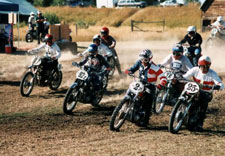 RD: Like the average vintage guy I pursued the dream of one day becoming a factory racer as long as I could, which in my case was 1980. By this point I had moved to the Philippines, North Dakota, Wisconsin, California back to Wisconsin and finally back to California. I had graduated to the 500 Pro Class, which was great but I only made money when the factory guys stayed home. I had a near fatal crash at Mammoth Mountain, then later that year I was competing in a Golden State Series race (which was the series that all the factory guys rode in the off season), at the track that David Bailey got paralyzed and in one of the motos I got lapped by Rex Staten. That was the day the dream died or reality kicked in the side of my head. RD: Like the average vintage guy I pursued the dream of one day becoming a factory racer as long as I could, which in my case was 1980. By this point I had moved to the Philippines, North Dakota, Wisconsin, California back to Wisconsin and finally back to California. I had graduated to the 500 Pro Class, which was great but I only made money when the factory guys stayed home. I had a near fatal crash at Mammoth Mountain, then later that year I was competing in a Golden State Series race (which was the series that all the factory guys rode in the off season), at the track that David Bailey got paralyzed and in one of the motos I got lapped by Rex Staten. That was the day the dream died or reality kicked in the side of my head.
Looking back I wish I would have had someone in my corner giving me some perspective on my decision to quit but I didn’t. All I knew was it took every dime I had to race, I had no time to train with a full time job and could see no future in the sport (professionally speaking) for me. So I quit, cold turkey and I sold my bike soon thereafter and devoted myself to my job.
The next few years I went from being a foreman for home remodeling crew to running my own company that specialized in residential energy conservation. My wife and I grew the company from two employees to sixty with locations from Bakersfield to San Jose. It was like having a tiger by the tail and it gave me something motocross never did, money, lots of money. What I didn’t have was time for anything else and it remained that way for years and years. I was a living example of the old adage of “all work and no play”.
It took about six years of keeping my nose to the grindstone before I started to get the bug to ride again. I forgot how to ride just for the fun of it and really did not want to relive the failure of not making it as a pro, so I bought a ’74 Yamaha TY250 trails bike. I figured I would just go out on my own and plonk around on the old bike in a field somewhere and get my motorcycle fix.
I probably had the bike in the garage for an hour before I started cleaning on it. One thing leads to another and before I knew it my new purchase was a pile of parts on the bench and floor. Over the course of the next couple of weeks I painted, polished and rubbed the TY into a pretty respectable looking bike. Not only was it fun to get reconnected with motorcycling, the wrenching aspect was mental therapy.
I immediately started looking around for something else to restore. You have to keep in mind that this was 1986 and there really was no internet by today’s standards and eBay was still a decade away. To find old dirt bikes was not an easy task. Word of mouth and the newspaper were about it. I decided to put an ad in the local paper that simply read “Wanted- Any Pre-75 dirt bikes, running or not.” We were still located in central California at the time, which is primarily farm land and not the epicenter for motocross like southern California but over the course of the couple of months I landed an Ossa and a Husky. I did the same garage style restoration on both of them and was happy with my newfound hobby.
 Then I read about a vintage dirt bike rally in northern California where they were actually racing these old bikes so I decided to check it out the following year. In the meantime, I decided to buy a new/used bike and try my hand at racing again. What an eye opener! The sport had changed dramatically in those six or seven years that I had been away. The track designs, disc brakes and style of riding were all different and I was an absolute dinosaur. It was like I never rode motocross before. If I wasn’t jumping nose high over a double jump, I was killing the motor with the super-sensitive rear brake, or slowing down twenty yards before the corner. I was a mess and quickly came to the conclusion that the sport had just passed me by and I was simply too old to participate. The modern bike consequently got parked. Then I read about a vintage dirt bike rally in northern California where they were actually racing these old bikes so I decided to check it out the following year. In the meantime, I decided to buy a new/used bike and try my hand at racing again. What an eye opener! The sport had changed dramatically in those six or seven years that I had been away. The track designs, disc brakes and style of riding were all different and I was an absolute dinosaur. It was like I never rode motocross before. If I wasn’t jumping nose high over a double jump, I was killing the motor with the super-sensitive rear brake, or slowing down twenty yards before the corner. I was a mess and quickly came to the conclusion that the sport had just passed me by and I was simply too old to participate. The modern bike consequently got parked.
The fall vintage rally finally rolled around and while it was still on my “must do” list so was the prospect of becoming a first time father. After six years of trying my wife was due at the same time. I was going to blow off the rally but she encouraged me to go because we had this new fangled device called a “cell phone” and if she went into labor she would just call me.
So went I did and when I got there I couldn’t believe how many people and bikes were there. It really was a happening. Watching the motocross was when the light bulb came on for me. The track was sensible and the bikes were simple, the people were my age and we all shared a similar past. I was hooked…again and hooked hard.
I started vintage racing soon thereafter and during the process I noticed that there was a serious lack of replica fender and handlebars, which made many of the bikes look goofy and uncomfortable to ride. I decided I was well enough off that I could afford to have some parts built and make them available to the racers and restorers. One mold leads to another and soon I needed a catalog to keep it all straight. With that Vintage Iron was born and we were as they say “off to the races.”
MR: I’ll ask you a one-two punch here; I know you were one of the early adopters, as well a contributing founder of our sport. What was the National scene like twenty years ago and how did you get involved in AHRMA?
RD: AHRMA was originally a road race based organization started by Rob Iannucci. He then turned it over to the board of directors and they saw merit in including other disciplines within the vintage motorcycle sport. Motocross was one of them. AHRMA boast 6000+ members today and I am #236, so that gives you a point of reference.
There was really only regional activity in Northern California at the time. There was nothing else going on period. There was also no Internet or wide press coverage so it was a fairly well kept secret.
I decided that I could help the cause by being the sponsor for the national series and held that position for approximately eight years and in that time I traveled on average over 40 thousand miles a year going from state to state helping plant the seeds that are now the national market. Jeff Smith and Dick Mann were at many of the events as well but I was the only one paying my own way to the tune of about $50K a year. I wish I had that money in my pocket now but I don’t regret it.
Turnouts were pretty light in the early years but the interest was there. It just needed time for the word to spread, the bikes to be bought and the restorations to be completed. Five years in, everything had changed. It was by no means rivaling modern motocross but it was able to stand on its own two feet and I felt proud that the effort had paid off and could make a contribution to the sport of motocross.
As time went by the idea of becoming a trustee seemed like a natural progression and I was encouraged to run for the board of directors, so I did. I was eventually elected and had finally made it into the “inner sanctum” of AHRMA. I think I served two terms but I could be mistaken as I have really tried to leave that whole time period in the sport behind. They were dark days full of disillusionment and disappointment. What I experienced there changed my opinion profoundly and charted a new direction for me; personally and professionally.
MR: Digging into my memory banks, didn't you start the Evolution (post-vintage) movement?
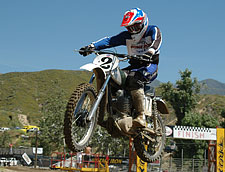 RD: That would be the direction change I was referring to, but I think I need to tell a bit of the back story for those who weren’t around the sport then and for those who believe the lies and fabrications that the “spin doctors” at AHRMA were pumping out at the time. RD: That would be the direction change I was referring to, but I think I need to tell a bit of the back story for those who weren’t around the sport then and for those who believe the lies and fabrications that the “spin doctors” at AHRMA were pumping out at the time.
When I came to the board of trustees it was my first time working in this capacity. I have always worked alone and the committee thing was new but I was up for the work ahead.
I read everything they put in front of me and tried to listen when the subject matter was beyond my scope or experience. I soon grew tired of representing all facets of the sport and only being knowledgeable about motocross. To rectify that I started road racing, riding trials and a few dirt track events. I wanted to know as much about the organization as possible and being a participant seemed like the best means to that end.
I also spent time studying the bylaws and the original intentions of the organization’s founder and in doing so I noted that two things were missing. One was that there was no mention of pre-1975 motorcycles anywhere. The second thing was that there was no clear road map to the future. That started me thinking about the sport in a long term sense and before long I realized that if we as a board did not chart a course and develop means to define “what is vintage” for the future, the organization, the racing and the bikes would lose significance as we became to old to participate. I thought it would be counterproductive to everything that we were doing to just ignore the future and let the sport whither away.
So I came up with a plan to start to look at the various aspects of the sport and how best to identify the bikes and the people that would soon become “vintage.”
The year was 1993 and I had just been awarded the “Sportsman of the Year” award, which was AHRMA’s highest honor. When I say just awarded, I mean like the day before in Daytona. There was an annual trustee meeting the day after the awards banquet and I was ready with copies of my plan for all the board members to follow along with and had rehearsed the presentation a dozen times. I was ready for almost everything other than what I got.
I started in with the fact that I had been studying the bylaws and the original intent of the organization and that I note the lack of pre-1975 anywhere in the document and that I saw no provisions for future development of the class structures. I said, “When my sons (then 5 and 6) are 35 the bikes that they will want to restore and ride have not been built yet. Hell they hadn’t been conceived of yet, so if we want a future generation to take over in our footsteps we should plan for it now because as trustees it is our responsibility.
Before I could go any further, Dick Mann piped in and said, “We don’t need to change a thing!”
I explained that I was not advocating changing what was existing, but rather developing some new classes for the future.
He said I don’t think you understand. We don’t need to change a thing. The sport became Supercross after 1974 and that is not what we are about now, nor will we ever be about!”
The room was the kind of silent that makes a ringing in your ears. I learned that day that there was no one on that board that would dare speak out in opposition to Dick Mann even though they would agree with me privately. I decided to drop it and be a get-a-long guy but when I got back home later that month I remembered over and over the responsibilities of a trustee and I wasn’t living up to them as long as I was ignoring the obvious, looming future.
I decided to be more prepared next time and try to address the issues and obstacles at the next trustee meeting. This time I would be even more ready.
The next meeting of the board was at Chicago I think and when all the formalities were dispensed with the meeting was opened up to new business. That is when I chimed in with “After our last meeting I got to thinking about the future of AHRMA and I am more convinced than ever, we should do all we can to create a road map and system for the organization to go smoothly into the future.”
Dick Mann’s face was redder than a thirteen-year-old boy caught pleasuring himself, except Dick wasn’t embarrassed he was pissed off. He demanded that we take an immediate vote on passing a moratorium against me being up this topic again for the next three years. Of course, he had enlisted the support of the villainous and venomous Jeff Smith in the months that had past and Jeff comment still sticks in my head. He said “You can do what ever you want to with this sport after we are gone but for now it is going to stay the same.” I responded with “So I am clear, you are saying that what is important to you and Dick Mann is more important than the future health of the organization?” He of course would not answer that rhetorical question but his actions and those of Dick Mann spoke volumes. That was the day the war began. The war of the future vs. the status quo as defined by Dick and Jeff.
I figured that I had done the Johnny Appleseed thing before so I could do it again. This time I would do it for the sport instead of doing it for AHRMA. The following year I dug in my pockets and put together an eight race national series for Evolution bikes that started in Florida and ended In California instead of hop scotching back and forth around the country. The next year we did the same. We got great press coverage and the concept started to spread around the world.
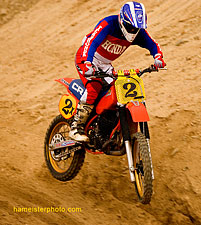 Years later AHRMA finally relented and adopted my class structures but never gave me any credit or apologized for the way they treated me, or my business during the years I was working to develop the Evolution series. No, they just changed the class names acted like the whole thing was their idea. Years later AHRMA finally relented and adopted my class structures but never gave me any credit or apologized for the way they treated me, or my business during the years I was working to develop the Evolution series. No, they just changed the class names acted like the whole thing was their idea.
Ironically today the Evolution class (post-1974) of motocross is not only alive and well, it is more responsible for saving AHRMA financially than any other form of racing.
People still ask me if I still hate AHRMA and I tell them the same thing time and again “I never hated AHRMA. I devoted too much of myself to building it to hate it. I hated that certain people felt they were more important than the sport itself. Lucky now the sport is bigger than anyone single person or organization for that matter.
MR: Where do you see the sport now and in the future?
RD: The sport is currently very strong worldwide, although the US economy is weak so it makes all motorsports look stagnant at best.
The basic framework for going into the future is set base on logical technological plateaus.
For example: Evo 1 or Pre78 encompasses the early long travel bikes that really hadn’t figured it all out yet. Evo2- is what I call the “original recipe” because it is what we started with; air-cooled, drum brake and no linkage. Evo 3- is the pre-disc brake era (the introduction of disc brakes is a huge advancement). Evo 4- is Pre-90. Decade is anything 10 years old and older.
What is next? Logic tells me that Evo 5 is going to be Pre-Four stroke and in our club (American Retrocross) that is right around the corner for inclusion. Hell, Evo 6 might be Pre-Hybrid or Pre-Solar if the Global Warming nuts have their way!
As long as class structures make sense I think the sport will be OK and continue to be a vital part of the overall sport. If people try and impose their own personality into the class structure or engage in revisionist history like AHRMA has with their Premier and Classic divisions, they will ultimately hinder the sport.
MR: Do you think AHRMA has hindered the sport?
RD: Absolutely.
MR: How can you say that when there are still so many members?
RD: I am not saying that the sport isn’t in good condition. What I am saying is that if AHRMA would have been more logical and responsive and less entrenched about the class structures, the promotion of the sport and the will of the members it could have been miles farther down the road. It is a classic example of arrested development perpetrated by people who do more to retain power than they do to advance the sport they are entrusted with. It makes a strong case for trustee term limits (something I tried to get passed but failed).
MR: What would you most like to be remembered for within the sport?
I would hope that folks would remember me as someone with vision that has championed the cause of vintage racing and as a pioneer in moving the sport forward both in racing and in business. Which is a politically correct way of saying I would hope that the red blooded Jofa wearing, two stroke air polluting racers of our sport would remember me as one of their own. One who was smart enough to see the value in our sport and had the balls stand up to those who have tried to hold it back, even when it did not benefit me personally.
Thanks for your time Rick, and thanks for your energy and perseverance!
|